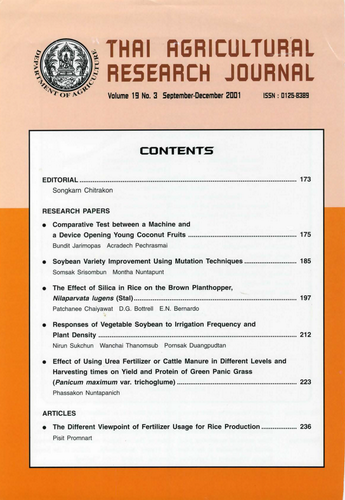Soybean Variety Improvement Using Mutation Techniques
Keywords:
soybeans (Glycine max (L.) Merrill), indrced mutation, soybean rust (Phakopsora pachyrhizi Syd.)Abstract
Induced mutation techniques had been used to improve soybean (Glycine max (L.) Merrill] varieties in Thailand since 1971. There were several objectives mainly disease resistance (rust, purple seed stain, crinkle leaf virus and anthracnose) including the improvement of agronomic traits (non seed shattering, short stature and early maturity), lower number of green seeds and saline soil tolerance. The accomplishment of the breeding was only from rust tolerance progran. Soybean sees of SJ4 cultivar were irradiated with a dose of 150 Gy gamma ray. A mutant variety Doikum showed lowe rust infections and gave 15% greater grain yield than that of the original SJ4 cultivar under epiphytotic conditions of the yield trials conducted during 1982 - 1985. Another experiment, soybean seeds of Chiang Mai 60 cultivar were treated with 100 Gy gamma rays. A new mutant line CM60-10kr-71 showed resistant to the rust disease. The line gave mean yield of 2.64 t/ha compared with 1.61 t/ha of Chiang Mai 60 under natural infection conditions of the yield trials conducted during 1995 - 1996. This elite line is being tested for yield and adaptability in farmers field to support release.
Downloads
Published
How to Cite
Issue
Section
License

This work is licensed under a Creative Commons Attribution-NonCommercial-NoDerivatives 4.0 International License.
Thai Agricultural Research Journal


